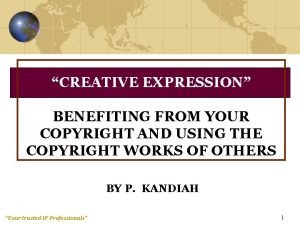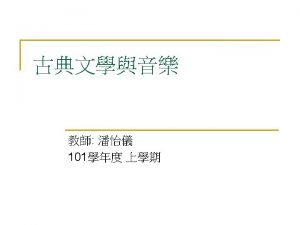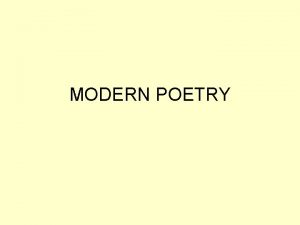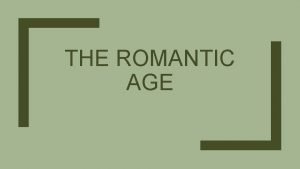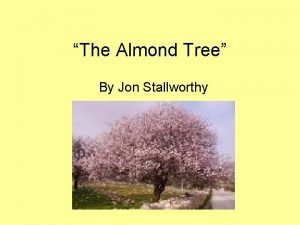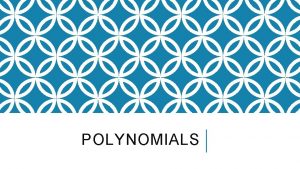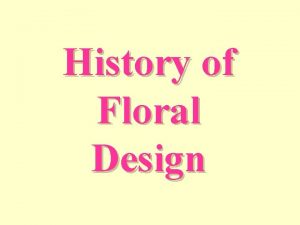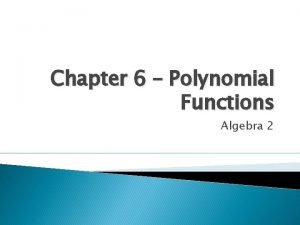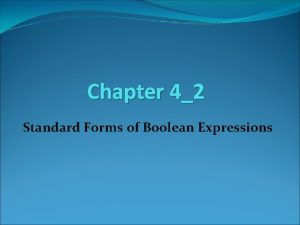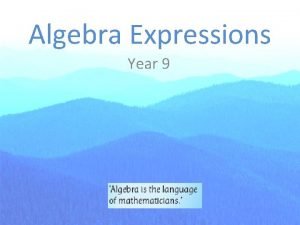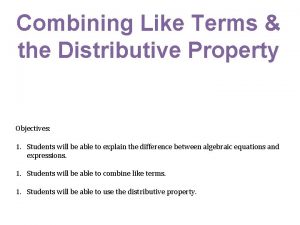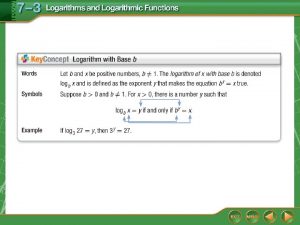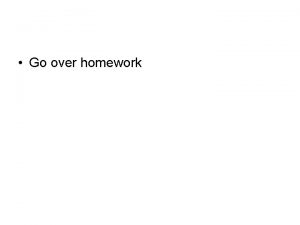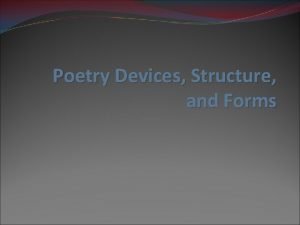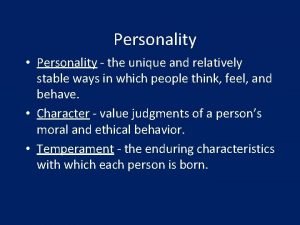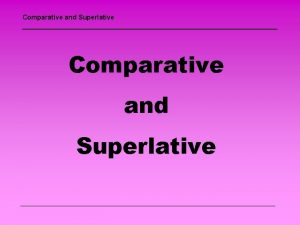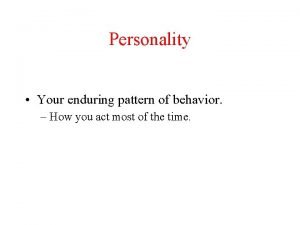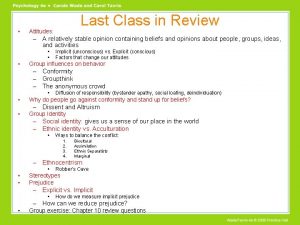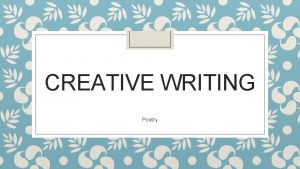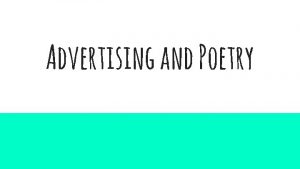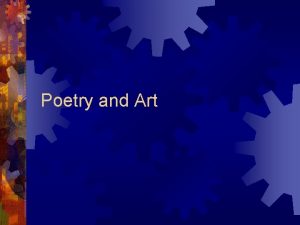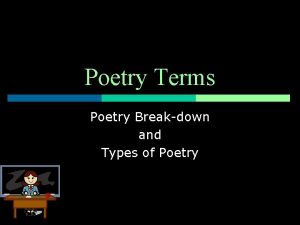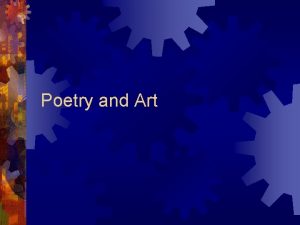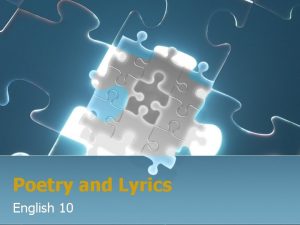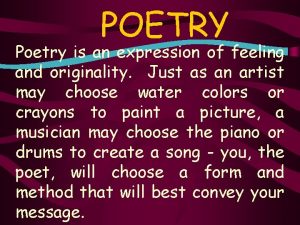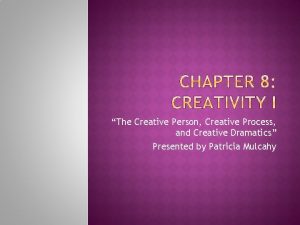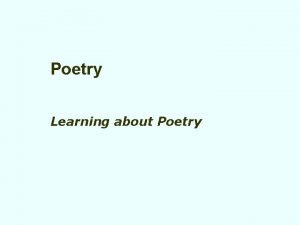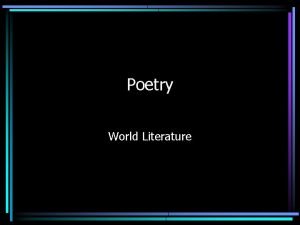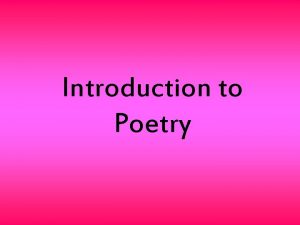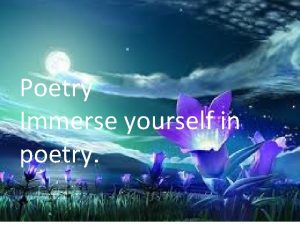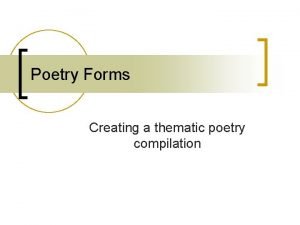Poetry A unique and creative form of expression
























- Slides: 24

Poetry A unique and creative form of expression

Poetry Appreciation § Reading a poem for its ‘total effect’ § Understanding poetic devices employed § Examples of poetry

Interpretation § Meaning – What is the poet/poem attempting to convey Story line of the poem Narrative or lyrical poem Theme

Interpretation § Language Question why the poet chooses certain words. What do they represent? What do you associate with the word?

Interpretation § Form Why is the poem arranged the way that it is? How does it reflect the content of the poem?

Interpretation § Sound Which poetic devices related to sound are being used? What is the rhyme scheme? How does the sound of the poem reflect the meaning?

Interpretation § Total Effect How do all the elements of the poem: meaning; language; form; sound; work together to create the ‘total effect? ’

Poetic Devices § Alliteration – The repetition of initial consonant sounds. Seven slithering snakes slid by. § Assonance – The repetition of vowel sounds. How now brown cow? In the total effect interpretation of poems, these poetic devices relate to sound.

Poetic Devices § Imagery – Words or phrases that appeal to any sense or any combination of senses. ‘I wandered lonely as a cloud That floats on high o’er vales and hills, When all at once I saw a crowd, A host, of golden daffodils…’ William Wordsworth

Poetic Devices § Metaphor – A comparison between two objects with the intent of giving clearer meaning to one of them. The sun was a golden coin. § Simile – A comparison between two objects using the specific words ‘like’ or ‘as. ’ She had eyes like a frog.

Poetic Devices § Meter – The recurrence of a pattern of stressed and unstressed syllables. § Iamb – A metrical foot, an unstressed syllable followed by a stressed one or short syllable followed by a long one. § Iambic Pentameter – A line of verse with 5 metrical feet. In a 10 syllable line of verse, every other syllable is stressed. (Popularized by Shakespeare)

Poetic Devices § Onomatopoeia – The use of words to imitate sounds. Buzz, Chew, Crunch, Sizzle, etc. § Personification – A figure of speech which endows animals, ideas, or inanimate objects with human traits or abilities. The winter wind howled and tormented us.

Poetic Devices § Point-of-view-The author’s/poet’s point-ofview is their vantage point of the speaker (or teller) of the story or poem. 1 st person: the speaker is a character in the story or poem and tells it from his/her perspective using ‘I. ’ 3 rd person limited: the speaker is not part of the story, but tells about the other characters with limited information about what one character sees and feels. 3 rd person omniscient: the speaker is not part of the story, but is able to ‘know’ and describe what all the characters are thinking.

Poetic Devices § Repetition – the repeating of words, phrases, lines or stanzas. The Bells by Edgar Allen Poe …with the bells, Silver bells! …bells, bells, bells…

Poetic Devices § Rhyme – The similarity of ending sounds existing between two words. They are all gone away, The house is shut and still, There is nothing more to say. Edwin Arlington Robinson

Poetic Devices § Rhyme scheme – The sequence in which the rhyme occurs. The first end sound is represented with the letter ‘a’, the second is ‘b, ’ etc. They are all gone away, (a) The house is shut and still, (b) There is nothing more to say. (a) Through broken walls and gray(a) The winds blow bleak and shrill: (b) They are all gone away. (a)

Poetic Devices § Stanza – The grouping of two or more lines of a poem in terms of length, metrical form or rhyme scheme. § Couplet – A stanza with two lines. § Quattrain - A stanza with four lines.

In Depth Interpretation § § § Ask yourself the following questions: What is the dramatic situation? What is the structure of the poem? What is theme? Are the grammar and meaning clear? What are the important images or figures of speech?

§ What are the most important single words used in the poem? § What is the tone of the poem? § What literary devices does the poem employ? § What is the prosody of the poem?

Review of Poetry § Poetry has its own form § The foot, line, and stanza are the building blocks § Meter and rhyme are sound effects of poetry § There are many types of rhyme forms § There are many types of poetic feet: iambic, trochaic, anapestic, etc.

Review cont’d § § § There are several stanza forms Narrative poetry tells stories Ballads are simple narratives Lyric poetry is subjective and emotional Odes are formal lyrics that honor something or someone § Elegies are lyrics that mourn a loss

Review cont’d § Dramatic monologues converse with the reader as they reveal events § The sonnet is a 14 line form of poetry § The villanelle is a fixed form that depends on refrains § Levels of interpretation depend on the literal and figurative meaning of poems § Symbols provide for many levels of interpretation

Review cont’d § When comparing and contrasting poems, remember to consider speaker, subject, situation, devices, tone and theme

§ Poetry interpretation and analysis considers a multitude of factors, and requires insight and understanding of language, words, imagery and literary elements to fully appreciate it.
 Creative expression examples
Creative expression examples Quadratic equation
Quadratic equation Ode to an athlete dying young
Ode to an athlete dying young Refers to writings in which expression and form
Refers to writings in which expression and form Affirmative present continuous
Affirmative present continuous Cavalier poetry definition
Cavalier poetry definition Experimentation in modern poetry
Experimentation in modern poetry Augustan age and romanticism
Augustan age and romanticism Almond trees poem
Almond trees poem American victorian flower arrangements
American victorian flower arrangements 4x²y, -3x²y, -7xy², 7xy²
4x²y, -3x²y, -7xy², 7xy² French era floral design
French era floral design Roman floral design
Roman floral design Polynomial expression standard form
Polynomial expression standard form Sop to pos conversion example
Sop to pos conversion example How to collect like terms
How to collect like terms Using distributive property and combining like terms
Using distributive property and combining like terms Log3 9=2 in exponential form
Log3 9=2 in exponential form Multiplication sign symbol
Multiplication sign symbol Sound imagery examples
Sound imagery examples Source traits examples
Source traits examples Unusual comparative
Unusual comparative Chapter 21 a unique prosperous and discontented time
Chapter 21 a unique prosperous and discontented time Enduring pattern meaning
Enduring pattern meaning The unique and relatively stable ways in which
The unique and relatively stable ways in which
